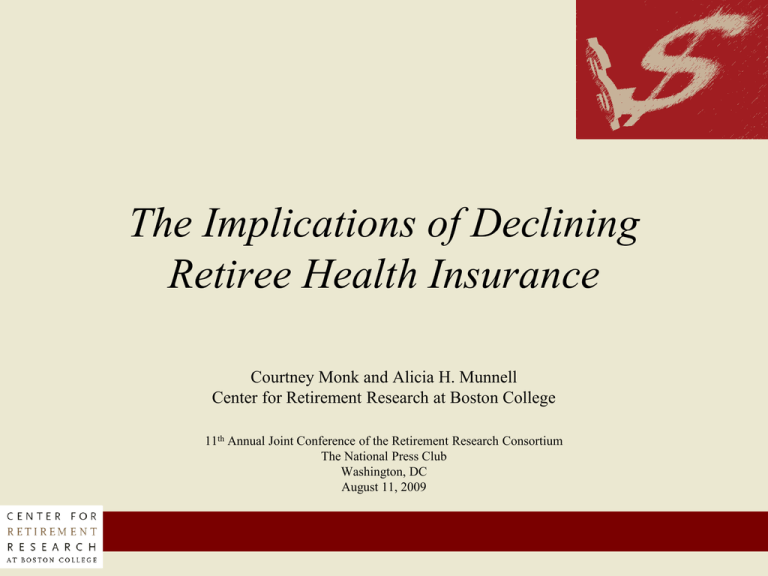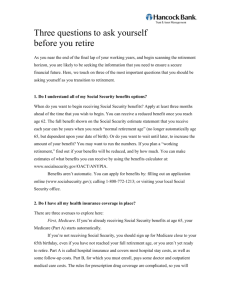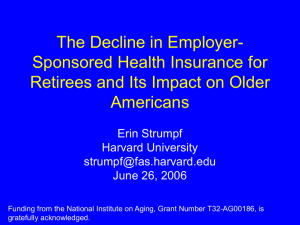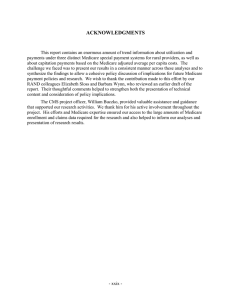The Implications of Declining Retiree Health Insurance
advertisement

The Implications of Declining Retiree Health Insurance Courtney Monk and Alicia H. Munnell Center for Retirement Research at Boston College 11th Annual Joint Conference of the Retirement Research Consortium The National Press Club Washington, DC August 11, 2009 1 Access to retiree health insurance (RHI) is falling, and its cost is rising. Percent of Large Employers Offering RHI to Active Employees, Selected Years, 1988-2006 70% 66% Median Monthly RHI Premiums, 2002-2006 (2006 Dollars) $150 60% $134 20 0 2 20 0 4 20 0 6 $125 46% 50% 40% 40% 38% $10 0 $10 0 $77 35% $75 30% $53 $50 20% 10% $25 0% $0 1988 1991 1995 2003 2006 $51 $34 Age 55-6 4 Age 6 5+ Sources: Gary Claxton, Bianca DiJulio, Benjamin Finder, and Marian Jarlenski. Employer Health Benefits 2008: An Annual Survey, 2008. Menlo Park, CA: Kaiser Family Foundation; and authors’ calculations from the University of Michigan. Health and Retirement Study (HRS), 2002-2006. Ann Arbor, MI. 2 1 For pre-Medicare individuals, RHI is an important source of coverage. Sources of Health Insurance, Age 55-64, 2006 Private, 7% VA, 2% Medicaid, 5% Medicare, 4% None, 11% Employer-sponsored health insurance, 55% RH I, 16 % Source: Authors’ calculations from the 2006 HRS. 3 2 What would happen to young retirees if RHI were no longer available? • Would individuals instead choose to work longer? • For those who still decide to retire before age 65, what health insurance options would they have? 4 3 Access to RHI affects the decision to retire. Marginal Effect of the RHI Offer on the Probability of Retirement, Married Individuals Aged 55-64, 1998-2006 5.9 % 64 7.3% RHI offer age 63 62 8.2% 61 8.3% 4.5% 60 6 .8% 59 9 .8% 58 10.4% 57 56 1.8% 6 .9 % 55 0% 2% 4% Statistically significant 6% 8% 10% 12% Not statistically significant Source: Authors’ calculations from the 1998-2006 HRS. 5 4 The withdrawal of RHI would cause some people to delay retirement. Average Conditional Retirement Rate for Those with RHI Access, 1998-2006 30% 26 % 25% 18% 20% 15% 10% 5% 0% Status quo RH I elim inated Source: Authors’ calculations from the 1998-2006 HRS; probabilities weighted by gender and marital status. 6 5 But a large group will still choose to retire and will lack affordable health insurance. Workers age 55-64 facing RHI withdrawal 82% 18% Keep working Retire 5% Access to insurance from spouse’s current employer 13% No employer-sponsored alternative Source: Authors’ calculations from the 1998-2006 HRS. 7 6 For people 65 and over, RHI is an important source of supplemental coverage. Source of Coverage, Age 65+, 2006 VA, 4% Medicare H MO, 17% Medicaid, 6 % Basic Medicare, 15% Medigap and other, 23% None, 1% RH I, 27% Employer-sponsored (working), 7% Source: Authors’ calculations from the 2006 HRS. 8 7 RHI is more generous than other supplemental coverage. Basic Medicare (Parts A & B) RHI Medicare Advantage (HMO) Medigap Part D Standard Medicare Medicare costsharing Prescription drugs Extra services (dental, etc.) Out-of-pocket maximum Source: Authors’ analysis. 9 8 So what would happen if RHI were no longer available to Medicare beneficiaries? • What kind of supplemental coverage would people choose, if any? • How would their out-of-pocket spending change? • How would their utilization change? • Would their health change? 10 9 We can predict the relative likelihood of choosing an alternative to RHI. Relative Risk Ratios, Multinomial Logit Results, 1998-2006 (Base Category: Basic Medicare) 1.1* Fem ale Non-white 1.4 0.7 0.2 1.2 1.2 One chronic condition 1.3 Two or m ore chronic conditions 1.5 1.1* 1.2 Risk averse 0.0 0.5 Medicare HMO 1.0 1.5 Medigap * Not statistically significant. Source: Authors’ calculations from the 1998-2006 HRS. 11 10 About half of RHI holders would select into Medigap. Predicted Insurance Choice for RHI Holders from the Multinomial Logit, 2006 RHI is withdrawn 48% 23% 29% Basic Medicare Medicare HMO Medigap Source: Authors’ calculations from the 2006 HRS. 12 11 Total spending would fall slightly on average, but OOP would rise for most. Mean 2-Year Spending For RHI Holders Before and After Switching, 2006 $12,000 $10,156 $10,000 $8,000 $7,535 $8,848 $8,522 $7,053 $6,698 $6,000 $4,000 $2,000 $0 Before After Before Basic Medicare Part B prem ium s After Medicare H MO Before After Medigap Part D & other private prem ium s OOP Source: Authors’ calculations from the 2006 HRS. 13 12 But OOP changes over an individual’s remaining lifespan would be small. Expected PDV of the change in OOP at age 65 RHI is withdrawn Basic Medicare ↑$16,441 Medicare HMO ↓$290 Medigap ↑$6,167 Source: Authors’ calculations from the 2006 HRS; CMS real medical cost growth projections. 14 13 Utilization would generally decrease. Percent Change in Utilization After Taking Up New Insurance, 2006 -4% -6% Prescription drugs -3% -15% -17% Hospital visits -5%* -5% * Doctor visits -7% * -5%* -20% -10% Basic Medicare Medicare HMO 0% Medigap * Not statistically significant. Source: Authors’ calculations from the 2004-2006 HRS. 15 14 Elimination of RHI would be unlikely to affect Medicare beneficiaries’ health. • Prior health is the key driver of current health. • A change from one type of insurance to another is unlikely to affect health. 16 15 Conclusion • Without RHI, some 55-64 year olds would delay retirement to retain their health insurance coverage. • Most would still retire early but would likely lack secure coverage. • Those over 65 would have to spend somewhat more for Medigap, but Medicare would still protect health outcomes. 17 16




